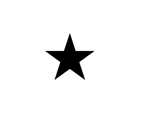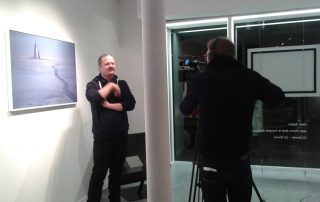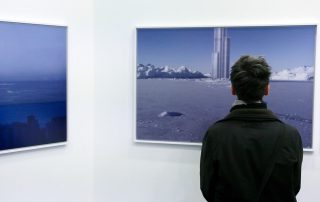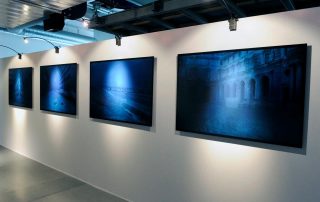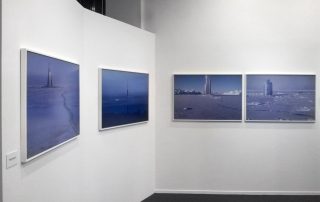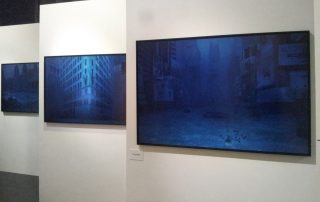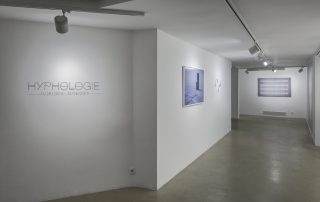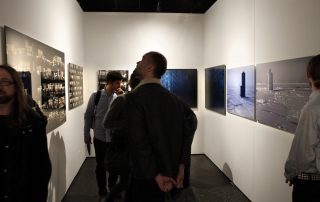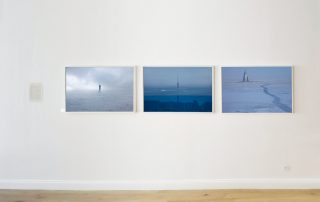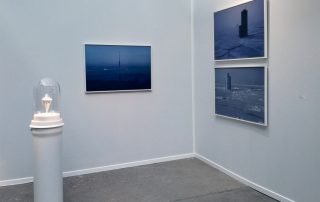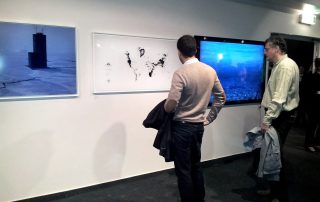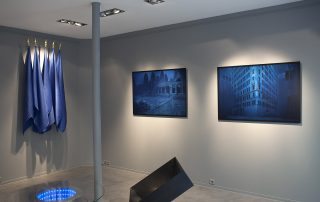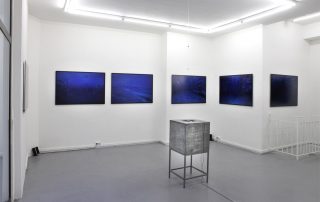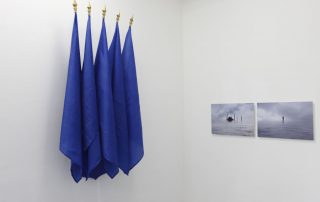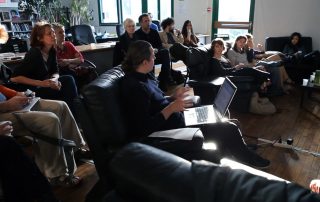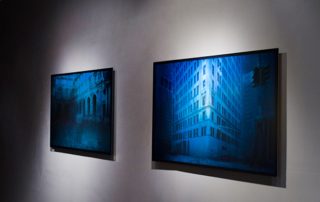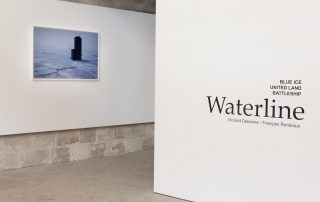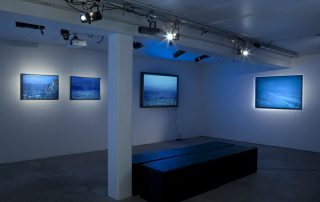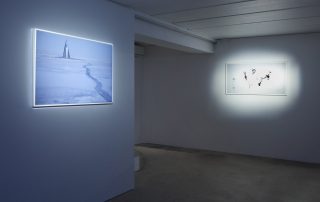Textes UNITED LAND
A l’heure bleue d’une contre-utopie
Les œuvres qui se donnent l’ambition d’un projet sociétal globalisant ne sont pas si nombreuses, surtout lorsqu’elles s’appuient sur des présupposés scientifiques. François Ronsiaux qui s’attache à une vision monumentale de sites urbains, développe son projet United land depuis plusieurs années. Celui-ci a donné lieu à plusieurs interprétations dont celle des projections nocturnes in situ de Paris Underwater réalisées dans le 20ème arrondissement de la Capitale pour la Nuit Blanche 2015. Mais sa version finale est un ensemble de photographies réalisées dans une dominante bleuâtre. Si la lumière bleue est principalement émise par le soleil, elle l’est de plus en plus, en intérieur, par la multiplication des sources lumineuses artificielles : éclairage halogène, LEDs, écrans d’ordinateurs et de smartphones. Ce choix esthétique a aussi le mérite de lier ces images à la question de la venue du sommeil ou plutôt de son empêchement puisqu’il est prouvé que la lumière bleue « leurre le cerveau » en émettant les mêmes longueurs d’onde que le soleil durant la journée. Elle trouble ainsi le rôle de la mélatonine, cette hormone naturelle produite en fin de journée et qui favorise l’endormissement. Symboliquement, l’annonce de cette heure bleue d’une humanité anesthésiée par ses technologies prépare le terrain d’un bouleversement des territoires de la vie.
On peut justement définir l’utopie en terme de « territoire imaginaire, parfaitement organisé où règne la concorde entre les habitants ; on sait que par extension, elle se constitue en modèle pour un projet révolutionnaire audacieux et idéal». Oscar Wilde affirmait son caractère primordial «Aucune carte du monde n’est digne d’un regard si le pays de l’utopie n’y figure pas». Une des formes physiques souvent utilisées pour la matérialiser est l’île. On peut en voir le fondement dans l‘Utopie de Thomas More. Son île, difficile d’accès, est constituée de 54 villes fortifiées, rigoureusement identiques: « Qui connaît cette ville les connaît toutes, car toutes sont exactement semblables, autant que la nature du lieu le permet ». Ce caractère insulaire et sériel trouve un héritier dans les œuvres de Philippe Calandre, telles Isola Nova (2012) ainsi que dans les suites de ce projet architectural général.
L’artiste luxembourgeois Bert Theis (1952-2016) a réalisé quant à lui en 2014 une série de photomontages de grands formats à partir de vues aériennes des villes de Milan, Munich, Paris, Tirana et Turin où la nature envahit l’ensemble des espaces urbains pour en faire une sorte de « jungle urbaine ». Il en écrivait : « Proposées en contrepoint des processus de transformation urbaine et des opérations de spéculation immobilière qui les accompagnent, ces « agglovilles » entendent démontrer qu’une autre ville est possible, parce que son image est possible. ».
La preuve par l’image, son rôle démonstratif, c’est aussi ce qui guide la production artistique de François Ronsiaux. Le propos général relève plutôt de la dystopie qui consiste à « projeter, à l’opposé de l’utopie, ce que craint l’auteur au lieu de ce qu’il souhaite ». Aujourd’hui, la dystopie est avant tout un genre littéraire, sous-domaine de la science-fiction qui inspire aussi des plasticiens établissant des projections dans un futur à partir d’un présent indésirable. « Toutes deux testent les limites de la réalité, l’utopie approche d’un idéal qu’elle atteint rarement – stoppée par le monde réel– et la dystopie rend visibles différents points de rupture et vulnérabilités » Michael D. GORDIN, Helen TILLEY et Gyan PRAKASH, in Utopia / Dystopia: conditions of historical possibility.
L’une comme l’autre envisagent des solutions globalisantes. Ainsi on peut voir dans United land le double héritage de deux séries du groupe florentin d’architectes radicaux réunis sous le label Superstudio. L’ambition générale ferait plutôt allégeance au Monument continu présenté par le groupe en 1969 qui se voulait « un modèle architectural pour une urbanisation totale ». Ils en déclaraient « l’architecture est un des rares moyens pour rendre visible l’ordre cosmique sur terre ». Cet ordre ou plutôt ce désordre cosmique Ronsiaux l’envisage comme la suite possible d’une apocalypse géomagnétique en référence à la théorie scientifique de l’inversion des pôles magnétiques de la planète. Le projet s’articule autour de la « Survival Map», Carte de Survie représentant la planète terre avec un niveau des mers supérieur de plus de 300m. Du fait de la perte de contrôle de l’homme sur son environnement, l’eau devient vecteur nivelant la totalité de l’environnement humain; suite à une redoutée fonte globale des glaces. On peut voir l’antériorité du projet dans la série Sauvetage des centres historiques italiens créé en 1972 par Superstudio suite aux séismes et crues ayant dévasté Florence et Venise « L’homme ne possède désormais d’autre science que celle de sa propre destruction. La ville est aujourd’hui submergée par le fleuve de l’histoire désormais contaminé et transformé en une marée d’eaux usées. »
Nicolas Moulin a revendiqué l’influence des florentins ce qui permet de situer United land au sein d’une famille (restreinte) de créateurs, en lien à des ensembles comme VIDERPARIS (2001) ou INTERLICHTENSTADT (2009) qui mettent aussi en scène des formes nouvelles de monuments. Ces artistes partagent la volonté de faire œuvre dans une logique traversant leurs différentes propositions sérielles. Les photomontages de François Ronsiaux se partagent entre deux univers colorés, si la lumière bleue y est dominante ; certaines scènes sont marquées par une ambiance plus froide évoquant des situations glacières. En 2016 ses œuvres plus sculpturales des Ice Clock sont constituées d’un « Groupe frigorifique, et d’impression 3d en acier inox et impression 3d sur époxy ». L’iceberg en suspension sous une cloche en verre fond en partie et se reconstitue cycliquement, inondant une partie d’un paysage artificiel soutenant la pièce.
Ces différents états d’inquiétudes écologiques quant aux territoires de survie humaine amènent la création de ce que Michel Lussault appelle des Hyper-Lieux dans son essai sous-titré Les nouvelles géographies de la mondialisation (Seuil 2017). Il les relie à ces phénomènes notamment climatiques où les évènements font lieu, il constate à leur sujet : «Le Monde contemporain est de plus en plus marqué par l’importance prise par l’imagination spatiale de la catastrophe.» Parce que le terme dystopie qui matérialise ces psychoses collectives est peu familier à un large public, on peut lui préférer son synonyme de contre-utopie. United land tente une approche ironique de cette mondialisation avec la série des drapeaux customisés au bleu de la catastrophe des nouvelles nations unies.
Christian Gattinoni
FRANCOIS RONSIAUX. UNITED LAND
by Klaus Fruchtnis
«United Land is a global photography and visual arts project that explores the notion of territoriality and men’s psychoses when confronted with the possible disappearance of his vital space»
Tell us about your approach to photography. How it all started? What are your memories of your first shots?
Francois Ronsiaux (FR): I didn’t learn photography in school but like many people in this period, I began to play with black and white films on objects, land art and urban life. I say “play” because at that moment it was not my plan to pursue this in a professional way.
The first significant photographic experience was during my first trip to New York when I was twenty-three. That was where I discovered my passion for pictures. I was so excited because the architecture was very different than in Europe and I spent a long time experimenting with photography, day and night for two weeks. Two years after that, I had the opportunity to enter the artistic network of squats in Paris and set up my first exhibition. It was the beginning of my personal research and experiment on photography and art in general and I had the opportunity to meet a lot of artists and to get different viewpoints on art.
How would you describe your personal research in general? How did your research evolve with respect to those early days?
FR: My photographic research in this previous period was focused on photosensitive emulsion of objects I created and to find a way to transcend the limits of the medium. My small apartment was transformed in a temporary laboratory during this period.
At the same time I decided to create an art structure to organize projects, to mutualise each others’ knowledge and ideas while collaborating in projects; “L’entreprise” is born in year 2000 and was a dynamic association of 40 members from different countries.
An the same time, photography techniques were in a strong numeric revolution; now it was possible for photographers to learn and develop their knowledge by themselves and control every part of the medium. For me it was the beginning of profound questioning and the possibility of creativity during the process of creating a picture. With this experience, I’m actually sure to work not only with photography but use all media to construct my art projects.
Tell us about your project ‘United Land’ that was exhibited recently at the Le Cube?
FR: ‘United Land’ project began in 2009, after 4 years of reflexion on the Indonesian Tsunami of 2004. ‘United Land’ is a global photography and visual arts project that explores the notion of territoriality and men’s psychoses when confronted with the possible disappearance of his vital space. The project is articulated around the «Survival Map», representing the planet earth with a sea level higher than 300m from the year 2012, date of creating the map. Every monument, building, natural element, exceeding a height of 300m is represented by a symbol and directs photographic mapping project.
‘United Land’ represents an instant of time where activity and movement are halted and human effort is subjected to contemplation thanks to utopic underwater landscapes that are definitively unaffected by outside influences with the exception of marine erosion. Symbolising men’s loss of control of the environment, water becomes a regulating vector replacing men’s habitat following a hypothetical ice thaw. Through this immersion the idea of belonging to a political and human territory loses all meaning and becomes an abstract. The different exposures taken all over the world are identifiable but in ‘United Land’ only the longitude/latitude co-ordinates are recognized – the photographs do not belong to any geopolitical identity.
What do you think about photography in the era of digital and social networking?
FR: Is it actually again possible to speak only about photography? A large part of artist photographs are similar to reality traficants and use not only photography but the ensemble of informatic possibilities to squeeze out their artistic concepts. One of my last projects ‘Posture’ is based on the concept of the disembodiment of the image and the perception of reality in the time of mass media.
The project tries a pictorial approach exposing the intrinsic link between power and politics by calling the symbols of our near or distant fantasy. For a subtle mix of different periods of history, the project consists of a storage device of a global aphorism based on impressions, mental images or historical preconceptions. Disembodied images and decontextualized objects play the score of a modern era where bits of multiple information are not considered participating in the more or less fantasized global collective imagination. Some pictures of the project ‘Posture’ diverted from their contexts are from journalistic, photographic from the web and have a copyright; their reappropriation is assumed and justified by the concept of the project.
You are also the director of a place dedicated to contemporary art diffusion, creation and resources, Plateforme. Can you tell us more about it.
FR: Plateforme is dedicated to contemporary art diffusion, creation and resource and works as a unifying and shared space, a place of exchanges between artists, curators and audiences.
Plateforme is run by the Parisian structure L’entreprise bringing together around fifty international artists and comes from a desire to create our personal concept of artistic place after our experience of artists squats. My personal point of view is that something is missing between creators, curators, galleries and the art market, the link is very difficult to develop and art is working on a linear approach. Plateforme tries to create a transversal way between them and expand the dialog between the different layers of art scene in a dynamic way.
Is there any contemporary artist or photographer, even if young and emerging, who influenced you in some way?
FR: I’m very sensitive towards artists who work on fiction and science fiction. One of the best experience of global art was Matthew Barney with the Cremaster exhibition in museum of modern art in Paris. He is officially a celebrity but formally not very popular with the critics and art professionals. Maybe because he draws on very commercial and attractive subjects. But for me the most important thing is to feel a project is totally habited.
In the photographic domain, a lot of interesting projects exist, for the French ones I like the Space project of Vincent Fournier who makes an interesting mix of fiction, true documents and mise-en-scène. The second is Nicolas Moulin, who uses false archives and futuristic architectural phantasms in his projects to create artificial black and white paysages. The third can be Vincent Debanne who uses not only photography but also 3D to create phantasmagoric stories and fictions on different subjects.
Is there any show you’ve seen recently that you find inspiring?
FR: For me one of the most interesting photographic exhibitions actually is Cinquième Corps of Noémie Goudal at Le Bal.
Three books of photography that you recommend?
FR: An interesting point of view on Photography: Roland Barthes, Camera Lucida. Reflections on Photography. The book Hope of Ewin Olaf. Post-Photography: The Artist with a Camera, Robert Shore, by Laurence King Publishing.
Projects that you are working on now and plans for the future?
FR: I work on a new installation of artificial icebergs under a glass dome, a mix between ice technology and 3D print; the first show of this project will be on Variation media art fair on the 17th of October 2016.
A new show of ‘United Land’ project will be on Sorbonne Art School in the second part of the year, and the actually Cube exhibition finishes on the 23th of July 2016.
One Artist Imagines What Our Urban World Would Like Look After The Next Ice Age
“Throughout the 21st century, man, with his never-ending drive to control his living environment, finds himself facing the possibility of a temporary existence,” writes French artist Francois Ronsiaux, “as well as the potentiality that life on Earth could end progressively or even abruptly.”
It’s a sobering concept, the thought that the ever-bustling life we know on Earth could end at any moment. Ronsiaux makes this particular future seem ever more real in his series “United Land.” The project turns photographs snapped around the world into stark imagery, manipulated with a perfect amount of paranoia and terror. Our urban spaces as we known them are rendered as submarine, part of an entire planet submerged in the aftereffects of an ice age.
For example, Ronsiaux takes an image of Times Square and filters it through a blue haze, degrading the familiar skyscrapers and billboards until they look like remnants of an apocalypse, left to rot below sea level. To create the scene, he uses a diaphragm correction filter that imitates shadows, captured with a long shot perspective that eliminates all movement — giving, as he explains in a project statement, the impression that the landscape is absent of inhabitants.
For the curious, the water shots used in these montages come from a database of images that Ronsiaux took on the Rangiroa atoll in French Polynesia, a popular destinations for scuba divers. The atoll is the largest in the world, but has been plagued by rising waters in recent years.
“Symbolizing man’s loss of control of the environment, water becomes a regulating vector replacing man’s habitat following a hypothetical ice thaw,” Ronsiaux continues. “Through this immersion the idea of belonging to a political and human territory loses all meaning. It becomes abstract.”
Though Ronsiaux vaguely references socio-economic and environmental deregulation as problems in our contemporary world, his photos aren’t a call to action. The thaw, without context, seems inevitable. If anything, the moral of his story is that our reality is fragile, and ultimately out of our control. Beyond his constructed photographs, Ronsiaux juxtaposes his end-of-times imagery with two installations — one, a “printed swatch” of national flags from around the world, reimagined in different shades of blue; the other, a set of five blank, blue flags that ominously hint at the dominance of water in a post-thaw realm.
Katherine Brooks
Exhibition views
Biographie François Ronsiaux
Né en 1974 en France
Vit et travaille à Paris
Artiste photographe plasticien, responsable de la galerie Plateforme à Paris, initiateur de la Biennale de l’Image tangible et président de l’association de promotion de l’art contemporain L’entreprise.
Représenté par la galerie Oliver Waltman, Paris, la Waltman Ortega gallery, Miami, la Source Photographica, Melbourne.
François Ronsiaux fait partie de ces artistes à la création protéiforme, exerçant son art sur des thématiques telles que l’ingéniering de la propagande, les idéologies modernes ou les évolutions environnementales ; il se construit aux grés de ses expériences un puzzle ou se mêle le hasard et sa propre recherche spirituelle sur son rapport avec le monde.
Utilisant les technologies et matériaux contemporains, François Ronsiaux à la base photographe crée des installations, performances, projets visuels et sonores à la limite de l’équilibre et dans des allégories de réappropriation des lois essentielles de la nature.
Sélection expositions/événements 2022 / 2001 :
2022
Exposition Extreme Exposure – Source Photographica gallery – Sorento, Australia – Juin / Aout
Exposition OUTLAND – Galerie Plateforme, Paris – janvier
2021
Exposition NOVOLAND – Philippe Calandre/François Ronsiaux – Dans le cadre de Photo Saint-Germain –
Galerie Olivier Waltman, Paris – novembre
Organisation/commissariat de la Biennale de l’Image Tangible – novembre
2020
Exposition/Editions Dedans-Dehors – Julio Artist Run Space, PARIS 20 – décembre
Exposition 28ème PARALLÈLE – Module #1 – AERO CITY – Galerie Plateforme – Paris – octobre
2019
Exposition 28ème Parallèle François Ronsiaux, Dorota Kleszcz – Nuit Blanche officielle – Le 100 ECS, Paris 12 – octobre
Fotofever Art Fair – Galerie Olivier Waltman – Carroussel du Louvre – Novembre
2018
Organisation/commissariat de la Biennale de l’Image Tangible – novembre/décembre
Exposition United Land – Nuit Blanche officielle – La Vilette / Folie N5 – octobre
Group Show – Aix en Provence – Galerie Goutal – juillet/aout
Exposition FICTIONS – La photographie aux frontières du réel – Aix en Provence – Galerie Goutal – janvier
2017
Exposition United Land – Institut Mines-Télécom – novembre 2017
Exposition SPACE ODDITY – Mois de la photographie du Grand Paris 2017 – Commissariat et Exposition –
projet Corridor / 28ème Parallèle – Maison des Arts de Créteil – avril / mai
ART PARIS ART FAIR – Grand Palais – Paris – Galerie Olivier Waltman – Ice Clock / United Land – avril
ART WYNWOOD – Miami – Waltman Ortega Gallery – projet United Land – février
2016
Variation media Art Fair – Projet ICE CLOCK – Cité Internationale des Arts – octobre
Carreau de Cergy – Projet UNITED LAND – Exposition collective Dans le regard de l’autre – novembre
Plateforme gallery Paris – Projet Guide avec Dorota Kleszcz – exposition à ciel ouvert en réalité augmentée
Une Journée de Coïncidences – Commissariat et exposition – septembre 2016 – septembre 2017
LE 100 – Paris : Projet POSTURE – exposition collective Digital Exartcise – Futur En Seine 2016 – Juin
Le Cube – Issy Les Moulineaux : Exposition collective System Failure – Projet United Land – fév/juil
2015
Plateforme gallery Paris : Exposition collective Si Vis Pacem, Para Bellum – Projet Posture – nov
Espace Jean Roger Caussimon – Tremblay : Exposition United Land et table ronde – nov
Paris 20 – Nuit Blanche 2015 : Installation lumineuse Paris Underwater – oct
Nunc Contemporary Gallery – Anvers – Belgium : Exposition personelle United Land – avril/mai
Hotel St Régis Moscow Nikolskaya – exposition United Land dans le cadre de la conférence Cop 21 – mars
Galerie Olivier Waltman – Paris 06 – Exposition Open Space – projet United Land et 28eme Parallèle – jan/fév
2014
Galerie Claude Samuel Paris – Mois de la photographie à Paris – projet Waterline avec Vincent Debanne – nov
Galerie Plateforme Paris – Mois de la photographie à Paris – projet 28eme Parallèle – nov
Galerie Plateforme Paris – projet Black Flag Meteorite – juin
Waltman Ortega gallery – Miami – exposition collective Mutations : projet United Land – fev/mars
2013
Galerie Sanatorium – projet Hyphologie – Istanbul – Turquie – nov/dec
Show Off Art Fair – new media art fair – Espace Pierre Cardin – Paris – nov
La Cale 2 Créateurs- Nantes – Festival Le Voyage à Nantes – exposition collective Norevover : projet 28ème Parallèle – juil/aout
Galerie Dock Sud – Sète – exposition collective Norevover : projet 28ème Parallèle – juil/aout
Galerie Waltman Ortega – Miami : Exposition collective Photography : projet United Land – juin/juil
Galerie Plateforme – Paris – exposition personelle : projet Jacob’s Mirage Park – mai
Cutlog New York Art Fair – Galerie Olivier Waltman – Le Clemente, New York : projet United Land – mai
On-Gallery – Pekin – Festival Croisements – exposition collective Norevover : projet 28ème Parallèle – avr/mai
Institut Francais de Tokyo – Japon – Instants vidéos : Difusion projet Atome Japon 2002 – fev
2012
Galerie Plateforme – Paris 20 – exposition collective Norevover / Mois off de la photographie à Paris : projet 28ème Parallèle – nov
NoFound PhotoFair – Galerie Olivier Waltman – Garage Turenne, Paris 03 : United Land – nov
Galerie Olivier Waltman – Paris 06 : Exposition personelle United Land – nov
Conférence / Uprade projet United Land – Maison populaire de Montreuil – mai
Exposition United Land – Salon 1.618 – Projet COAL – Cité de la mode et du design – mars
2011
Galerie Plateforme – Paris 20 – exposition collective Point d’impact – projet Absorbtion de masse
Galerie Plateforme – Paris 20 – exposition personnelle United Land – photographies / vidéo
Lauréat finaliste du prix international d’art contemporain de la fondation François Schneider 2011
2010
Exposition collective Previously on Optical Sound – galerie Frédéric Giroux – Paris : photographie 28eme parallèle
Galerie Olivier Waltman – Paris 06 : Projet Echelon
Galerie Plateforme – Paris 20 – exposition collective Donne lieu à présence / Mois off de la photographie à Paris : projet Echelon, photographie sonore
Galerie Plateforme – Paris 20 – exposition collective Little Big Bang : installation 3 cubes de béton
2009
Central Slovakian Gallery – exposition collective Allégories / Identités – Slovaquie : photographies
Kennory Kim Galerie – Paris 04 – exposition collective In wonderland : photographies
2008
Exposition Casino’23 – galerie Le Dojo à Nice avec Pierre Belouin: photographies
La nuit de la photographie contemporaine – Place St. Sulpice – Paris : photographies
Evènement Insomnies, L’entreprise à la Maison d’art Bernard Anthonioz soutenue par la Fondation nationale des arts graphiques et plastiques – Nogent sur Marne : projet 28éme parallèle
Radio Libertaire – Epsilonia – Paris: concert/performance Zone avec Dorota Kleszcz
2007
Kennory Kim Galerie – Paris 04 – exposition collective Assonance : photographies
International Art Meeting – Galerie BWA Katowice Pologne : performance Zone avec Dorota Kleszcz
Kennory Kim Galerie – Paris 04 – projet collectif addict avec Dorota Kleszcz : projet 28éme parallèle
Festival international des cultures électroniques Mal au pixel – Main d’oeuvres – Saint-Ouen : performance Zone avec Dorota Kleszcz
Evénement Heaven de l’association L’entreprise à l’OPA Bastille – Paris 11 :
performance Zone avec Dorota Kleszcz
Centre culturel Jean Cocteau – Paris – Les Lilas – exposition collective Perte relative de trajectoire : photographies
Kennory Kim Galerie – Paris 04 – projet collectif addict de Dorota Kleszcz et François Ronsiaux :
projet 28éme parallèle
Festival photographique international Fotofest à Wroclaw – Pologne : projet 28eme parallèle
2006
Galerie Nowa Laznia – Cracovie – Pologne – Mois de la photographie:
installation vidéo Silésie temps des énergies
Galerie Sous réserve – Créteil – projet collectif addict de Dorota Kleszcz et François Ronsiaux :
projet 28éme parallèle
Événement Transports non communs – In Fact et L’entreprise au Couvent des Récollets – Paris :
installation vidéo 3d Poésie Autonome
V Wroclaw Industrial Festival – Pologne : performance Zone avec Dorota Kleszcz
2005
Festival 18 es Instants vidéo – Centre culturel de Fos sur Mer : vidéo Atome Japon 2002
2004
Galerie Nikki Diana Marquardt – Place des Vosges Paris 04 – exposition collective Silésie Temps des Énergies : photographies
Espace Cosmopolis – Nantes – exposition collective Silésie Temps des Énergies : photographies
Festival WIK / WIB – Katowice – Bytom – Pologne – projet de l’association L’entreprise : photographies, installation, performance multimédia, vidéo Atome Japon 2002
Maison de la Photographie NPDC – Lille – exposition collective Silésie Temps des Énergies : photographies
2003
Pulp – Paris – événement Composite # 05 spécial Tokyo : projection d’images, vidéo
Galeria Isabela Carvalho – Sao Paulo – Brésil exposition collective The Last Factory : photographies
Espace Nesle – Paris 06 – exposition collective Assonance #1 : photographies, installations
Galerie Nikki Diana Marquardt – Place des Vosges – Paris 04 – exposition collective The Last Factory : photographies, vidéo, installations, performance
2002
Théâtre 347 – cité Chaptal – Paris 09 – Street Level Industries _ Sonic Research Lab :
musique improvisée, vidéo, performances
Musée de la photographie de Cracovie – Pologne – exposition personnelle Réalité transcendante
Usine Gaupillat – Meudon – exposition collective Work In Paris : photographies, installations
2001
Espace Confluences – Bd de Charonne – Paris – exposition collective C Cession
Théâtre 347 – cité Chaptal – Paris – exposition personnelle Rétrospectif
Théâtre 347 – cité Chaptal – Paris : organisation et participation Les ateliers de L’entreprise –
événement interactif multimédia – interaction pluridisciplinaire
Galerie Annie Stansal – Rue de Montmorency – Paris – exposition collective L’entreprise
